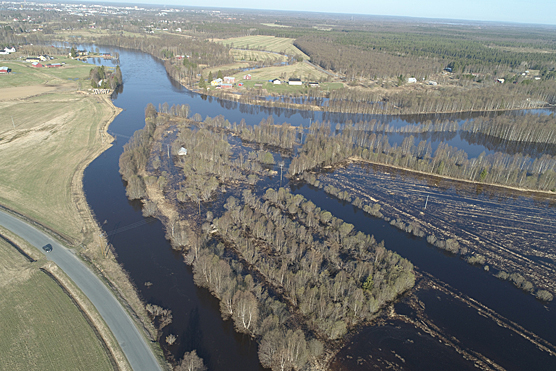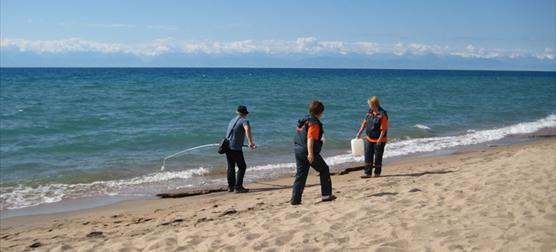Decision analysis methods unite differing stakeholders in water management

© Milla Popova
SYKE has developed multi-criteria decision analytical methods and applied them to water resources management and, more generally, the tapping of natural resources and environmental planning. It has also developed approaches for water security assessment and resilience management.
Taking conflicting interests into account
The method was developed to identify problems, to take economic, ecological and social impacts as well as the values and objectives of different stakeholders into account and analyze various management options.
Thanks to multi-criteria decision analysis (MCDA), a compromise has been reached with stakeholders in many projects on how to improve the sustainability of water management practices. MCDA was also applied to several land use planning projects, including analyses related to the location of peat extraction in support of zoning work by provincial associations. SYKE has prepared handbooks for EIA and SEA cases in Finland and other EU countries and has a handle on the social aspect of water, energy and food security in Finland under climate change and other large-scale drivers.
Powerful tool shuts down opposition
SYKE has in-depth understanding of how MCDA could be applied in different types of planning and decision-making situations with stakeholders and what are the good practices in its use. Real-world projects suggest that MCDA has the capacity both to open up and close down environmental policy discourses, and thus it can be a powerful tool in complex environmental problems where there are conflicting interests. There are challenges in the use of MCDA (e.g. procedural and behavioral biases in weight elicitation), but the risks can be diminished.
For more on the impacts:
-
IMPERIA LIFE + (2012 - 2015), which improved methods for Environmental Impact Assessment procedure.
-
Winland project (2016 - 2018) which developed water security and resilience assessment methods.
-
OPENNESS project which applied multi-criteria methods to deal with trade-offs, synergies and conflicting interests and values in the use of ecosystem services concept.
- Utilizing ecosystem service classifications in multi-criteria decision analysis – Experiences of peat extraction case in Finland. Mustajoki, J., Saarikoski, H., Belton, V., Hjerppe, T. & Marttunen, M. (2020). Ecosystem Services, 41, 101049.
- Methods to inform the development of concise objectives hierarchies in multi-criteria decision analysis. Marttunen, M., Haag, F., Belton, V., Mustajoki, J., & Lienert, J. (2019). European Journal of Operational Research, 277(2), 604–620.
- A Framework for Assessing Water Security and the Water–Energy–Food Nexus—The Case of Finland. Marttunen, M., Mustajoki, J., Sojamo, S., Ahopelto, L. & Keskinen, M. (2019). Sustainability, 11(10), 2900.
- Improving resilience of reservoir operation in the context of watercourse regulation in Finland. Mustajoki, J. & Marttunen, M. (2019). EURO Journal on Decision Processes, 7(3), 359–386.
Hydrological and water quality system predicts floods and nutrient loads

© Photo City of Tornio
The WSFS-VEMALA hydrological modelling system was launched in 1981, to serve operational water resources and water quality forecasting and management, and to advance research. This system constitutes the knowledge foundation of flood control in Finland.
Since 2000, the hydrological simulation and forecasting system WSFS has covered all of Finland.
Currently the system includes also an integrated hydrological-nutrient loading-model (WSFS- VEMALA) and a deterministic biogeochemical model, for the assessment and quantification the ecological state of inland waters. WSFS-VEMALA is connected to the coastal marine model (FICOS) to cover the entire hydrological continuum from the inland watershed via the coast coastal to the marine Baltic Sea.
Load estimates of nutrients from forest and peatlands are included, to allow assessing the impact of harvest and drainage and to support management. Recently SYKE has added models of carbon loads from agricultural, forested and peatlands in order to simulate inputs of dissolved organic carbon into inland waters.
The modelling system is used for:
- Planning water protection measures and management impact under the Water Framework Directive (WFD)
- Evaluation of water-borne nutrient loading pressures from point and diffuse sources, source apportionment, and impact on lakes, rivers and coastal waters
- Evaluation of national nutrient load and reduction needs for the HELCOM Baltic Sea Action plan
- Real time operational flood mitigation, water power production and lake regulation planning
WSFS increasingly important
Based on WSFS simulation and forecasts, daily and weekly hydrological outlooks are produced by the national Flood Centre, where an officer in duty works 24/7 during flood situations.
Applying and developing WSFS supports science, policy and practice integrated to risk management and climate change mitigation. The system is used in several research projects and programs for simulating and projecting of climate change impacts on water resources, flooding, droughts, groundwater and snow.
WSFS is also in use in Latvia by the national administration, in Sweden by power companies and Russia’s Murmansk area for reservoir regulation.
SYKE modelling tools can be also used for planning of cost-efficient management of nutrient recycling as part of circular economy solutions and to mitigate the increasing environmental pressures caused by the structural change in animal husbandry.
For more on the impacts:
-
Watershed simulation and forecasting system
-
VEMALA – a water quality and nutrient load model system for Finnish watersheds
-
Flood modelling
-
Hydrological situation and forecasts
- Blöschl, G., Hall, J., Parajka, J., Perdigão, R. A., Merz, B., Arheimer, B., Koskela,J.J. & Čanjevac, I. (2017). Changing climate shifts timing of European floods. Science, 357(6351), 588-590.
What if there were no water? Planning ahead for severe drought
From Failand to Winland is an interdisciplinary research project of not only researchers but officials, too. They are tasked with providing different scenarios of the future, identifying possible threats and ways to counter them. Experts of various fields, researchers and officials talk to each other.
SYKE offered its expertise in the area of water management. The project provided the country with the first ever comprehensive estimate of all factors contributing to Finland’s water supply security. The project also came up with suggestions on how to prepare for challenging situations.
SYKE developed, together with Aalto University, a systematic approach for evaluating the current status of Finnish water supply security and its development up to 2030. They also studied the effects of long-term drought on water reserves, whether they would suffice and the possible effects of climate change on drought.
Municipalities working together
In 2019, the municipality of Laitila, in the midst of the least water-abundant region of Finland, conducted a make-believe scenario of severe drought and looked for solutions, especially from the viewpoint of water supply and agriculture. The workshop produced 200 measures for mitigating drought, and 20 recommendations based on them. There were 40 participants; municipal and national officials as well as representatives of the private sector, including the Laitila beer/soda factory, whose operations are very water-intensive. According to feedback, all considered the exercise useful. The workshop resulted in a policy brief.
The unusually dry summer of 2018 has alerted officials and decision-makers to the fact that Finland with all its lakes could also experience a shortage of water, hence their interest in the project and its findings. The project has won praise from the Seurity Committee, the National Emergency Supply Agency and e.g. the Ministry of the Environment and the Ministry of the Interior.
For more on the impacts:
- Ahopelto, Veijalainen, Guillaume, Keskinen, Marttunen & Varis (2019). Can There be Water Scarcity with Abundance of Water? Analyzing Water Stress during a Severe Drought in Finland. Sustainability 2019, 11(6), 1548
- Veijalainen, Ahopelto, Marttunen, Jääskeläinen, Britschgi, Orvomaa, Belinskij & Keskinen, 2019. Severe drought in Finland: modeling effects on water resources and assessing climate change impacts. Sustainability 2019, 11, 2450.
-
From Failand to Winland project - exploring future energy, food and water security in Finland
Reduction of active pharmaceutical ingredients in the environment
Reducing the input of pharmaceutical ingredients into the environment is one of SYKE's priorities, and the topic has been addressed in a number of past and present SYKE projects. Through them, new information has been obtained both on the sources of active pharmaceutical ingredients (APIs) and on various ways to decrease their flow. Environmental risks related to API residues have also been assessed.
The projects have reaffirmed that in Finland the main sources of APIs entering the environment are human excretion and effluents from pharmaceutical manufacturing plants, while leaks from landfills and farms also occur. API residues were found both in surface water, sediments and agricultural soil, and the risks they incur were calculated on the basis of measured concentrations.
By testing different methods for removing APIs from wastewater SYKE's projects have contributed to improved control of API outflow from municipal wastewater treatment plants. The results show that each method, ranging from oxidation to filtration and adsorption, has its advantages and limitations and that no single method suits all pharmaceuticals. A combination of methods is therefore needed. Experiences from these projects, both from pilots and large-scale installations, will be turned into guidelines for operators of wastewater treatment plants.
It is, however, recognized that in the case of pharmaceutical industry, it may be more efficient and technically feasible to reduce API effluents at their primary source rather than at the waste water treatment plant. Accordingly, SYKEs projects have analysed environmental permits issued to the pharmaceutical industry and identified the best practices adopted by the industry. On this bases, recommendations were given to competent authorities and to the industry itself, aiming at a more comprehensive consideration of API residues in the permits.
For more on the impacts:
The cooperation with Kyrgyzstan improves the condition of their waterways

Water sampling in Kyrgyzstan. Photo: Natalia Baidakova.
Supported by SYKE’s water expertise, Kyrgyzstan is currently developing an assessment of the condition and sustainable use of the Son-Kul lake, significant for mountainous and hiking tourism in the country, but is currently polluted by environmental toxins.
Evaluated at the same time are the lake’s restoration potential and a possible environmental impact of the restoration work. Supported by SYKE, Kyrgyzstan is also creating a new, open-source digital environmental information system, where companies and organizations of citizens will have a key role in sustaining and utilizing the system.
For more on the impacts: